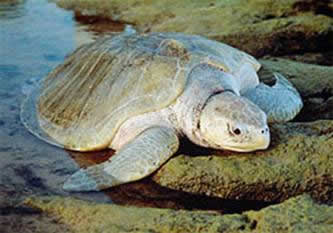-Shivani Thakur Singh
The environment is a fragile thing. Although self-sustaining, it is fast losing out the battle against human intervention. With tigers, leopards, chiru and other species on the verge of extinction; there are many who are on the endangered
category. The Olive Ridley Turtles found in India and only on the Orissa coast are one such species.
 Olive Ridley turtles get their name from the coloring of their heart shaped carapace (shells), which starts out as grey but reaches an olive green once they reach adulthood. Their life span is between 50 and 60 years reaching reproductive
maturity at 10 to 15 years of age and remaining reproductively active for 21 years. Their diet usually consists of crabs, clams, shrimps, mussels, sea urchins and jellyfish. These carnivores survive on mosses and algae also. Inspite of their extremely gentle
behavior this species is being threatened. But the main culprit in their declining population are humans. The coastal areas like elsewhere in India are major areas for fishing. Olive ridley's get killed due to gill nets and trawlers used by fishermen. The
fishermen use big mechanized trawlers. These turtles are hurled aboard along with the fish. The demand for turtle meat is high in Japan. The traders get a good deal for their meat. This rampant demand along with water pollution and natural breakdown of nests
contents which creates fungus and bacteria that destroys the buried sea turtle eggs are causes for their decreasing numbers.
Olive Ridley turtles get their name from the coloring of their heart shaped carapace (shells), which starts out as grey but reaches an olive green once they reach adulthood. Their life span is between 50 and 60 years reaching reproductive
maturity at 10 to 15 years of age and remaining reproductively active for 21 years. Their diet usually consists of crabs, clams, shrimps, mussels, sea urchins and jellyfish. These carnivores survive on mosses and algae also. Inspite of their extremely gentle
behavior this species is being threatened. But the main culprit in their declining population are humans. The coastal areas like elsewhere in India are major areas for fishing. Olive ridley's get killed due to gill nets and trawlers used by fishermen. The
fishermen use big mechanized trawlers. These turtles are hurled aboard along with the fish. The demand for turtle meat is high in Japan. The traders get a good deal for their meat. This rampant demand along with water pollution and natural breakdown of nests
contents which creates fungus and bacteria that destroys the buried sea turtle eggs are causes for their decreasing numbers.
 A major wildlife organization put the figure of turtles killed at last count to 2000. In the past thirteen years around 1,29,000 carcasses have been found. Last year around 9000 turtles were found dead. In March alone 1,700 deaths
were recorded in a single incident. These deaths raise a question mark on conservation of turtles. Most prominent areas where deaths were recorded, were in Devi river mouth and Paradip. Trawling has been prohibited till 20 km off coast here but on January
13, 2006 eleven trawlers were found fishing 2-3 km off the coast. In Delhi , the ministry of environment and forests refused to comment on their declining population arguing that it is state subject. With government empathy at the center and state level, their
plight has been ignored. The ‘passing the buck ‘ policy has resulted in bringing the turtles on the endangered list.
A major wildlife organization put the figure of turtles killed at last count to 2000. In the past thirteen years around 1,29,000 carcasses have been found. Last year around 9000 turtles were found dead. In March alone 1,700 deaths
were recorded in a single incident. These deaths raise a question mark on conservation of turtles. Most prominent areas where deaths were recorded, were in Devi river mouth and Paradip. Trawling has been prohibited till 20 km off coast here but on January
13, 2006 eleven trawlers were found fishing 2-3 km off the coast. In Delhi , the ministry of environment and forests refused to comment on their declining population arguing that it is state subject. With government empathy at the center and state level, their
plight has been ignored. The ‘passing the buck ‘ policy has resulted in bringing the turtles on the endangered list.
Belinda Wright of Wildlife Protection Society of India has pointed out that both the environment ministry and Orissa government have been asked to stop the deep-water trawlers from entering the restricted area. In the past 10 years the
uses of deep-water trawlers have risen. These trawlers not only kill fish and turtles but also destroy the biomass that supports them. Also, the offshore oil exploration in the area could mean adverse impact on the future of the species. In 2004 the Supreme
Court gave Central Empowered Committee the direction to ensure their protection but nothing has been done so far. Also, the patrol boat at Nuagarh fishing base sits idle despite orders for day night patrolling. This continuance ignoring of the situation will
only result in dwindling population of the turtles.
The task forces come out once any species reaches the extinction level. Are we all waiting for animals or birds to reach their minimum numbers before we take any action or can we make efforts while we still can???
(Photo of Olive Ridley by WWF-Guy MARCOVALDI
Stamp issued by India in 2000)